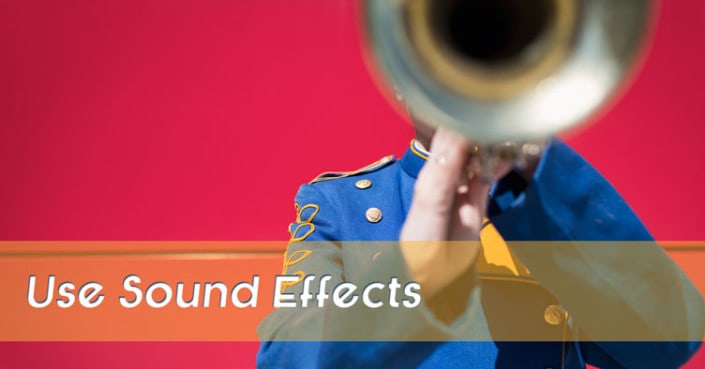Great storytellers do two things very well. First (obviously), they tell stories.
Second, through their stories, they get people to act.
You might be thinking, “That’s great if you’re Steve Jobs and introducing the iPhone, but what do I do with all of my everyday dry and boring content? How do I turn that into a story, let alone a gripping one?
Well today I’m going to help you out with 15 insanely actionable storytelling tips and tricks to get you into the storytelling mindset, regardless of what type of material you’re working with.
If you are looking for ideas for how to start your presentation, see our guide here.
Second, through their stories, they get people to act.
You might be thinking, “That’s great if you’re Steve Jobs and introducing the iPhone, but what do I do with all my everyday dry and boring content? How do I turn that into a story, let alone a gripping one?
Well today I’m going to help you out with 15 insanely actionable storytelling tips and tricks to get you into the storytelling mindset, regardless of what type of material you’re working with.
Once you have these story telling tips down, you can see how to start a presentation here.
How to start a story?
Getting your story started is oftentimes the most difficult part of the storytelling process, especially when you are in a professional setting.
You might know what your story is about and the point you want to make during your presentation, but getting it started can feel weird or awkward.
Don’t overthink it, just dive in and get started.
And if you feel stuck, use one of the following lines to jump start your story (and then don’t look back).
“Before we get started, I want to tell you about…”
Great for a smooth start, kick off your story (and the presentation) with this phrase and then tie it into your presentation message.
“That reminds me of the time…”
1. Find your characters and make them the focal point of your presentation

1. Break down your topic into the people (or characters) involved
Look at your material and simply ask yourself “who” until you have some people to work with.
99% of the time, someone’s actions, needs, vision, goal, etc., lies behind the point you are trying to make.
Very little happens in the world without people’s involvement. As such, this is one of the best storytelling techniques for business presentations.
For example:
- Your company’s quarterly earnings = hard-working employees or loyal customers;
- Your new product or service = a new demographic of consumers;
- Your data points = the people who did something to create those data points;
- Your school’s new program = the students benefiting from the new program or the representatives who fought to fund the program.
2. Pick a representative to follow
If you end up with a group of people from step #1 (for example, baby boomers getting ready to retire), try to narrow your group down to a representative individual you can talk more directly about.
Why?
Because if you’re talking about retirement products, it’s more interesting to hear about 62 year old John who is looking forward to driving his camper van across the country when he retires (cool)…
…rather than financially stable baby boomers getting close to retirement (yawn).
How this will improve your story
Stories need characters to move forward, and whereas objects and data points don’t have a story, the people behind those objects and data points do.
Simply re-orienting your presentation around the people involved in your topic (who they are, what they are doing, etc.), even if only briefly, will naturally create a story that your audience can begin to follow.
Seriously, the next time you watch a politician speak, see if they don’t break down their topic into individual people whose actions back up their point.
It’s a simple storytelling tip, but it’s one of the most impactful…especially for business presentations which are often data and product focused, instead of people focused.
2. Set the stage by describing where you are now and where you want to be in the future

1. Describe where things are now (the undesired now)
What is (or was) the “undesirable now” about your topic that drove the first action?
Set the stage for your knight in shining armor.
For example:
- Are credit card companies preying on college graduates by extending them credit and encouraging them to spend it, even if they don’t have any income?
- Are employees given limited and risky options to build their nest eggs to get to retirement?
- Is it common that people who spent all day on their feet develop blisters between their toes…regardless of what kind of shoes they wear?
Tip: Make sure your undesired state counts and is something people care about, otherwise you will lose your audience.
Your goal here is to get your audience invested in your topic.
As a bonus, highlight how you might feel about it. How painful would it be to walk with blisters between your toes?
2. Describe where things want to be (the desired future)
Now that your audience is on board about the situation, what are you going to do about it?
Now is your chance to paint the picture of the desired future that we all want to be a part of.
For example:
- College graduates are extended credit based on their actual earnings to avoid long-term financial disaster.
- Employees are given multiple options to safely build their nest eggs for retirement.
- People who spend all day on their feet can wear microfiber toe socks that eliminate 99% of all toe blisters.
Paint a picture of what the future would look like where everyone’s needs are met. Describe it in vivid detail.
Again as a bonus, describe how someone might feel about it. Does a college graduate who has avoided a mountain of credit card debt feel ‘just okay,’ or are they ‘pumped up about life’ and exited for the future?
How this will improve your story
It’s the change and/or transformation that happens within your story that is going to capture your audience’s attention.
Typically the change or transformation in your story is based around unmet needs, wants and desires (something that is not as it should be) that then brings forth some kind of action or sequence of events that result in meeting those needs (potentially your product or service).
If you find that your topic doesn’t have a change or transformation associated with it, moving from an undesired state to a desired state, rethink the angle of your presentation topic to come up with something that does.
To learn more about this specific storytelling technique and see how effective it is, see Nancy Duarte’s TED Talk, the secret structure of great talks or read a free multimedia version of her popular book “Resonate” online.
3. Describe what needs to be overcome and highlight why this will be difficult

1. Brainstorm two or three obstacles or challenges that are in the way
What is it about your presentation topic that is difficult to overcome or why can’t the characters in your story (see Tip #1) have what they want (see Tip #2)?
If there is nothing standing in the way then you don’t have much to talk about.
Common challenges include time, money, connections, proof, education, a competitor, a market, a county, natural disasters, the economy, etc.
2. Narrow down the obstacles to focus on your situation
With a few obstacles in mind, think about how they are unique to your situation or maybe particularly hard to overcome in this specific scenario.
Narrowing down your challenges to the specifics helps to create intrigue and curiosity about your topic, especially if your audience feels that they are already familiar with the broader obstacles in question.
Instead of writing you off, your audience will be interested to know how these obstacles impact your own unique situation, and how you will try to overcome them.
How this will improve your story
Stories are rooted in conflict and tension, and it’s the process of encountering obstacles and then overcoming them that propels a story forward.
Without any obstacles to overcome (and therefore, conflict and tension), you don’t have the basic foundation of a story.
People want to know what you are up against and what you are going to do about it. This is why including the specific challenges you are facing is such a great storytelling technique for drawing your audience into your topic.
4. Emotionally invest your audience in the struggle (define failure or the status quo)

1. Think about what failure means in your presentation
What happens if nothing works out and you fail at your endeavor? What are the short-term and long-term consequences of failure?
Or what would happen if we stayed with the status quo?
Put another way, think about what you are trying to help people avoid or solve with your presentation and why it should matter to your audience.
2. Describe that failure in human terms that your audience can relate to
Set the stakes by describing what failure looks like in human terms that your audience can relate to.
For example: If your presentation is about saving for retirement and you are trying to push young people to start planning, paint the picture of what retirement looks like when you are short on cash and forced to continue working?
Bonus Step: Focus on the emotional aspects of the failure
How does your character feel (or should your audience feel) emotionally about that possibility of failure?
What does the stress or regret feel like for having not started planning for retirement earlier?
How painful could it be if it negatively impacted your children, forcing them to take care of you financially when you got older?
How this will improve your story
Setting the stakes of what’s involved lets your audience know whether they should pay attention to your presentation or get their cellphones out and check email.
If nothing is at stake within your presentation, then you will have a difficult time getting your audience to care and invest themselves in what you are saying.
5. Emotionally invest your audience in the outcome (define what success looks like)

1. Think about what success means in your presentation
What happens if everything works out, the obstacles are overcome, and everyone runs off together into the sunset?
Think of what you are trying to accomplish with your presentation and why it matters to your audience.
2. Describe that success in human terms that your audience can relate to
Drill down the success you are working towards into human terms, based on your audience’s own goals.
For example:
If your presentation is about saving for retirement and you are trying to push them to start planning, describe what retirement looks like (in detail) with all the money you need already saved up and sustaining your lifestyle.
What does it look like to have a well-planned retirement?
Bonus Step: Focus on the emotional aspects of the success
How does your character feel (or should your audience feel) emotionally about that possibility of success?
What does it feel like once the goal is accomplished?
For retirement, how relaxed and thankful would you feel, knowing that you planned ahead and didn’t need to worry about your future?
Or your children’s future?
How this will improve your story
Emotionally engaging your audience in the success of your story will encourage them to stay tuned and inspire them to take action.
Think of it from your own perspective. If there is no pot of gold at the end of the rainbow, why even bother heading off in that direction in the first place?
People need a reason to take action, which is why investing them in the success of your topic early on is such a great storytelling tip.
6. Challenge your audience’s assumptions by adding a twist

1. List out the obstacles of your presentation
Go back and find all of the obstacles or challenges that you are overcoming within your presentation (see Tip #3).
2. Find an ‘obstacle within an obstacle’ or a chain reaction of obstacles
Looking at your list of obstacles, ask yourself if there is an ‘obstacle within an obstacle’ or a potential hidden twist to one of the obstacles that could jeopardize the entire outcome.
The twist might not have actually happened, but could have been problematic had it not been avoided.
For example:
Maybe you’ve convinced 3 members of the 4 member board of the viability of your project (which is already tough), but you need unanimity… and it turns out that the fourth member is your ex-wife’s father.
3. Add the twist partway through your presentation to create uncertainty
Add your twist partway through your presentation to lead your audience to doubt the outcome of your story.
If you are trying to add tension to your presentation, the last thing you want is everyone to know exactly where you are going and feel that they already know the outcome.
How this will improve your story
Gripping stories have twists and turns that not only raise the stakes of what’s involved, but they challenge the natural assumptions of the audience and make them reevaluate the potential outcome.
You can see this storytelling technique in action in just about any movie…you think you know exactly how the story will play out, but then a new element is introduced that throws you for a loop.
Adding an ‘obstacle within an obstacle’ or a twist, reengages the audience by creating curiosity and a loop with an unknown ending
7. Onboard your audience with an interesting metaphor THEY can relate to

1. Find a hard to relate concept or “thing” in your presentation
Think of what you have trouble explaining in your story.
Maybe you feel that it requires “too much” explanation or that it seems a bit dry or hard to grasp.
2. Relate that “thing” to something that your audience is already familiar with
Think of what you can relate that “thing” to that your audience might already intimately familiar with?
Is your new product or service the “McDonalds of phone covers”?
Or was your ex-spokesman the “Tiger Woods of water polo”?
For example:
Howard Schultz, the CEO of Starbucks didn’t just talk about the trials and tribulations of the company (a long-winded story) at an investor meeting…
Instead, he related the company’s struggle to the journey of a spawning salmon that has to constantly fight its way upstream.
He even went one step further and pulled out a frozen salmon from an icebox onstage to create the extra visual impact.
See Bruna Martinuzzi’s short YouTube clip on Leadership and Presentation Skills Training to learn more about this storytelling technique.
Warning: Choose your metaphor wisely as you will inherit all of the negative baggage of the metaphor that you use.
How this will improve your story
Metaphors are key to anchoring your story in the audience’s mind and can help you quickly summarize long-winded and hard to explain concepts in just a few sentences.
Applying this storytelling tip to your presentations will help keep your story relatable and memorable.
8. Show your audience exactly what you are talking about

1. Find the critical detail(s) about your presentation
Look at your presentation and find the one or two critical details that you want to get across.
These are the points that you want the audience to remember if they only remember one or two things at all.
2. Show your audience exactly what it looks like
Use either a visual image, a video, or better yet, a physical object to show your audience exactly what you are talking about.
Example #1: If your product is so skinny it can fit into a manila envelope… grab an envelope and slip your product into it.
Boom, point taken.
Example #2: If your point that the United States debt of over $15 trillion, when placed onto pallets of $100 bills, is taller than the statue of liberty, show your audience an infographic.
To actually see what this looks like, see a visualization of United States debt.
How this will improve your story
Seeing is believing, which is why visual imagery plays two vital roles in your presentation:
First, visuals can clearly describe or show exactly what you are talking about…often times better than words.
Second, assuming your imagery is on point, visuals can create an emotional reaction in your audience and get them to really ‘get’ what you are talking about.
Imaging the audience thinking: “Wow, I can’t believe that product can fit inside a manila envelope, how cool is that!”
9. Highlight the important by cutting out the unimportant

1. Look through your presentation and highlight your most important details and points
Find the meaningful details that help to advance your story (the ones without which your story wouldn’t make any sense).
These are the details you want to keep and highlight throughout your presentation.
2. Evaluate the other details in your story and remove the unnecessary ones
With your critical details in hand, look at the other points you raise and see if you need them at all.
Do they help your audience retain your message or help to highlight your point?
If not, cut them.
For example:
Have you ever had someone over-explain something and you immediately started losing interest?
That’s exactly what you want to avoid.
Spend time on the necessary details that prove your point or make your case, and avoid everything else.
How this will improve your story
Vivid and compelling details (see Tip #14) are critical to the success of your presentation, but too many details (or irrelevant details) will overwhelm and confuse your audience.
You will always have more details and information to share with audience than you will ever have time to speak about…especially if you have been working on something for years (which is what often makes this tip so hard to implement).
10. Use sound effects to anchor important details in your presentation

1. Think of what might have a distinct noise associated with it in your presentation
Look at the details of your story and find one or two items that have a sound associated with it (or a sound you could make up).
2. During the delivery of your presentation, make or play that sound
When delivering your presentation, either make the sound of that object yourself, or play a recording of it to anchor it in your audience’s mind.
For example:
Maybe you’re talking about how we’ve come so far from the time of the old dial-up modem, you know, the one that used to go “ca-chink-shhhhhhhhhh”…
Or maybe you’re talking about cracked cell phone screens and you highlight the sound of your $500 cell phone kissing concrete for the first (and likely the last) time (crkkkkkkkk)… whoops!
Story Telling Tip Warning About Sound Effects
- Don’t go overboard here. If you have a lot of sounds you could use, focus only on the important ones (see Tip #10) that would help add color to your story.
- If you are playing an audio track (i.e. not making the noise yourself) make sure you have everything set up properly before the presentation. The last thing you want to do is get derailed by technology problems.
How this will improve your story
Adding sound to the details in your presentation will help anchor those details in your audience’s mind.
You can draw them into your presentation, either with a sound that they are extremely familiar with or one they are not familiar with (leading to curiosity).
Even if your noise or sound effect is way off, it can add a bit of humor to your presentation and create some relief!
11. Use silence to create emphasis and draw your audience into your story

1. Find a part of your story that you want to emphasize
This could be an important point or detail that you want to have sink in, a turning point in your presentation, or a self-reflecting question.
2. Pause in order to force reflection
During your presentation when you get to that important detail or point, pause for five or six seconds (it will feel like an eternity), and then continue.
For example:
Did you know that there are now more English speakers in China, than in the entire United States? [Pause…]
How this will improve your story
Using silence in a presentation is a powerful storytelling technique that creates anticipation and forces your audience to rethink what you just said.
It forces the audience to momentarily “fill the gaps” in their minds and creates a potentially crucial time for reflection.
It also helps you to pace out your story (see Tip #13) and create more breathing room for both you and your audience.
Ultimately, a story that draws the audience in and causes them to actively process what you are saying is a successful story.
12. Create a warm fuzzy feeling by sharing a personal or vulnerable experience

1. Think of your own personal story to add to your point(s)
Think of some of the important points you want to make during your presentation.
With a few in hand, see if you can come up with a personal story, either one of your own or one of a friend or family member that you can use to illustrate your point.
2. Tell the personal story as it relates to your topic
During your presentation, insert your own personal experience BUT keep it short and on topic.
While a personal story can create a bond with your audience, a rambling, irrelevant story will take you off topic and derail your story.
For example:
A story about the new car model you’re launching can start with an old photograph you found of your grandfather leaning on the hood of his car and how much he cared about craftsmanship.
Bonus Step: Choose a personal story that shows vulnerability
The more your personal story shows yourself as vulnerable or flawed, the more rapport you will build with your audience by telling it.
How this will improve your story
Adding your own experiences to your presentation will help you in at least 2 ways:
First, it’s a story you are already familiar with and it will naturally come out in a story format (kudos!)
Second, it will help frame your story in personal terms with a real example, which in turn creates a bond between you and your audience that fosters trust.
Warning: Your personal story might even be the one thing your audience takes away from your presentation, so choose wisely.
13. Pace out your story to allow your audience to breathe

1. Find the natural breaks in your presentation
Look at your presentation and mark out all the different places when it takes a step.
In other words, see if there are natural breaks where you can make a long pause (see Tip #11).
If you can’t find many, think about re-organizing your presentation so that there are more individual pieces that you can pause in between, pacing the story out.
2. Make clear notes of those breaks and force yourself to take them during your presentation
Write into your script (or burn it into your brain) the note to take a pause.
A few seconds can feel like an eternity when you are in the spotlight, but your audience won’t feel that way (guaranteed!).
So pace yourself, it’s not a race.
How this will improve your story
Good stories have a pace or rhythm to them…everything doesn’t happen all at once, and you should never feel rushed.
Pacing out your story will give you and your audience a bit of brain space to process what was just said and ready yourself/themselves for the next part.
14. Turn your important data points into memory glue

1. Collect the important numbers for your presentation
Find the key driving data points in your presentation, whether the numbers are big, small or medium-sized.
2. Turn your data into something interesting and memorable
With your important data points in hand, think of how you can relate those numbers to something visually impactful in human terms that backs up your message.
For example:
Let’s say your data point is that 25 to 30 million Christmas trees are sold every year during the holidays, you could create different visual images depending on your point.
If your point is “that’s a lot”, you could say that if you took all of the Christmas trees sold in a single year, and lined them up tip to stump, they would circle the entire globe (it’s true, I did the math)!
If your point is, “that’s NOT a lot”, you could relate the trees to grains of sand, and say that all of the Christmas trees sold in a single year would only fill up 25 to 30 coffee cups.
Either way, whereas 25 million trees is hard to comprehend, envisioning a line of trees circling the globe, or 25 coffee cups of sand, is a lot easier.
How this will improve your story
Adding visual cues about your important numbers will help anchor those details in your audience’s minds and give them salient points they can easily recall after your presentation is over.
The more you can relate your data to common visual elements, the easier your data points will be to remember.
The easier your data points are to remember, the more likely someone will be able to remember your main points days, weeks or months after the presentation.
15. End your story with a bang…and then shut up

1. Think about your core message and what you want someone to say about your story
What key point should your audience walk away with knowing or feeling after sitting through your presentation?
2. Make your final statement and make it memorable
Take your key point and make it memorable.
If you are struggling, see if one of the following mechanisms makes sense for your last statement or slide:
- A call to action: “Join the movement”
- A question: “So the question is, can we really afford the status quo?”
- A quote: “And as Quincy Jones once said, ‘a big laugh is a really loud noise from the soul saying, ain’t that the truth.’”
- A soundbite: “Yes we can”
For more ideas on ending your presentation, see our guide here.
3. Practice how you’re going to wrap up your presentation
Take the time before your presentation to practice what your last 3-4 sentences will be (yes, say it out loud).
This is will be your last chance during your presentation to make an impact and get your audience to take action and/or care…so you want to make sure the ending is as impactful as possible.
If you can clearly envision how you’re going to end your talk with a bang, and if you have practiced, you’ll get it right.
4. During the presentation, say your conclusion and then shut up, get off stage, or open up for questions
And that’s it!
No last rambling comments. No off the cuff stories or tangents. No nothing.
Say your last bit and be done with it.
How this will improve your story
With a clear-cut and well thought-out ending, your audience will sit up and take notice as your presentation comes to an end, and they’ll know exactly what you want them to do.
This is a particularly good storytelling technique for business presentations as it puts you light-years ahead of other presenters who unconsciously ramble on and on, as if they are afraid to end their presentation.
Ending with a bang additionally highlights how well organized and knowledgeable about your material you are.
How to tell a story?
Now that you have these storytelling tips down, you might be wondering how to bring it all together.
You may be sitting there with a pile of data and a number of different story angles to work with, but now you are wondering how you are going to bring it all together.
Well, in the same way that your presentation needs an outline, so does your story you tell.
According to Christopher Booker, author of The Seven Basic Plots: Why We Tell Stories, all stories follow one of seven basic plot lines like the Quest, the Rebirth, the Rags to Riches story , etc.… plot structures that we are all familiar with.
By organizing your storytelling around a well-known plot like this, you’ll ensure that your story is easily recognizable and easy for your audience to follow along with (increasing the success and impact of the story you tell).
At the end of the day you can tell your story anyway you like, but following a standard plot structure will dramatically improve the effectiveness of your story when incorporating the storytelling tips mentioned above.
Now it’s up to you!
Those are 15 storytelling tips and tricks you can use to take your everyday material and begin crafting a story.
Some are simple, others take some time to figure out. But if you use even just one of them in your business presentation, you’ll be one step ahead of 90% of presenters out there!

A valuable list that every presenter should refer to before they step in front of an audience.
Thanks Ian!
Fantastic information. Thanks for sharing so freely. I’m a newbie at this and can hardly wait to apply what I have learned before I forget it.
Thanks Charlotte! Let us know how you do and if you learn any other new tips along the way!
Cheers,
Camille
Lots of novel and useful tips here, so thanks for sharing. I especially like the advice about being vulnerable – but to date I’ve found that too hard to do!
It’s interesting that you suggested using sound effects, too. I gave that same advice (here), especially for webinars, because novelty draws people in (and sticks in their minds so well).
Being a good storyteller is extremely difficult, but I just love it when speakers know how to choose the right words and run a smooth but interesting story. I think that you should use all of these techniques that you describe selectively considering the audience and the effect that you want to have.
I prefer to focus on the visual component – presentation and interesting eye-catching visual techniques. But at the same time, I have weak speaking skills (worse than I would like to have to make great presentations).
Here is a good list of resources that I use to develop my speaking skills: https://www.thoughtleadershiplab.com/Resources I think this list will be useful. There are some examples of how to use the techniques that you describe.